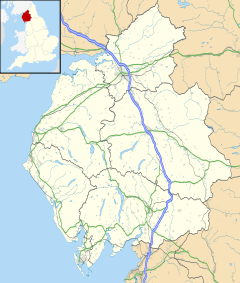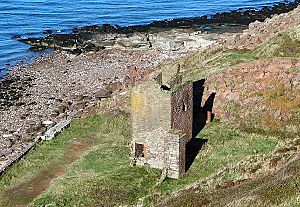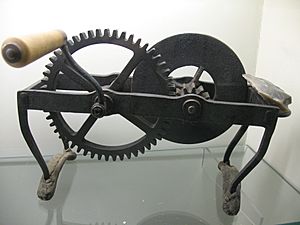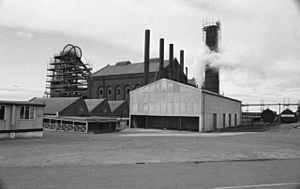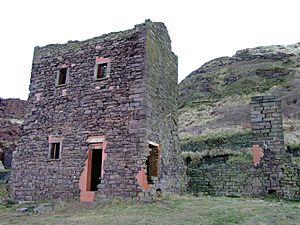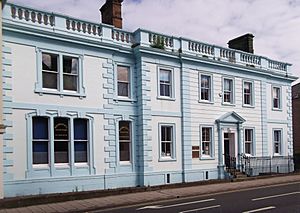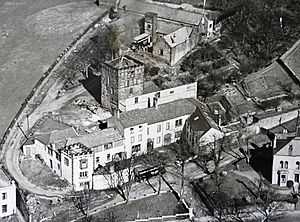Whitehaven facts for kids
Quick facts for kids Whitehaven |
|
|---|---|
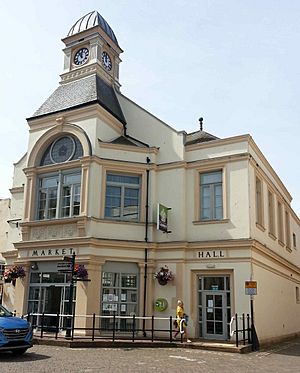 Whitehaven Market Hall |
|
| Population | 23,986 (2011) |
| OS grid reference | NX974181 |
| Civil parish |
|
| Unitary authority |
|
| Ceremonial county | |
| Region | |
| Country | England |
| Sovereign state | United Kingdom |
| Post town | WHITEHAVEN |
| Postcode district | CA28 |
| Dialling code | 01946 |
| Police | Cumbria |
| Fire | Cumbria |
| Ambulance | North West |
| EU Parliament | North West England |
| UK Parliament |
|
Whitehaven is a town and port located on the northwest coast of England. It is close to the beautiful Lake District National Park in Cumberland, Cumbria. The town is about 38 miles (61 km) southwest of Carlisle. In 2011, Whitehaven had a population of 23,986 people.
Whitehaven grew a lot because of its coal mines. The Lowther family helped develop these mines. Coal was shipped from the harbour starting in the 1600s. Whitehaven was also a big port for trading with the American colonies. Between 1750 and 1772, it was the second busiest port in England for shipping goods.
This success led to the town being carefully planned in the 1700s. Many of its beautiful Georgian buildings still stand today. Over 170 buildings in Whitehaven are officially protected. The Council for British Archaeology calls Whitehaven a "gem town" because of its historic look.
After World War II, Whitehaven had a large chemical industry. However, both the chemical and coal industries have now closed. Today, the biggest employer is the nearby Sellafield nuclear site. Whitehaven includes areas like Mirehouse, Woodhouse, Kells, and Hensingham. It is connected by the Cumbrian coast railway line and the A595 road.
Contents
- Whitehaven's Early Days
- How Whitehaven Grew and Became Rich
- Coal Mining in Whitehaven
- Whitehaven's Climate
- How Whitehaven is Governed
- Whitehaven Harbour: A Busy Port
- Town Planning and Architecture
- Railways in Whitehaven
- Marchon Chemical Company
- Sekers Fabrics: A Fashion Story
- Cumberland Curled Hair Ltd
- Sports in Whitehaven
- "Jam Eater" Nickname
- Maritime Festival
- Local News and Media
- Digital TV Switchover Trial
- Famous People from Whitehaven
- Twin Cities
- Images for kids
- See also
Whitehaven's Early Days
Even though there was a Roman fort nearby, there is no sign of a Roman town where Whitehaven is now.
Irish-Norse Vikings settled in this area in the 900s. The name of the area, Copeland, suggests the land was bought from the Kingdom of Strathclyde. It might have been bought with treasures from Ireland.
Around 1120, after the Normans arrived, St Bees Priory was built. This priory was given a large piece of land, including the small fishing village of Whitehaven. In 1539, Henry VIII closed the priory. The land then went to different owners until the Lowther family took over in the 1600s.
How Whitehaven Grew and Became Rich

Whitehaven's modern growth began when Sir Christopher Lowther bought the Whitehaven estate in 1630. He then started to develop the port and the mines. In 1634, he built a stone pier. This pier protected ships and helped export coal from the Cumberland Coalfield, especially to Ireland. This was a key moment in the town's fast growth. It changed from a small fishing village into a busy industrial port.
In 1642, Sir John Lowther, 2nd Baronet, of Whitehaven (1642–1706) took over the land. He greatly developed Whitehaven, its coal industry, and trade with Ireland. He saw Whitehaven grow from a small village of about 50 houses to a planned town three times the size of Carlisle. When he died, Whitehaven had 77 ships and exported over 35,000 tons of coal each year.
Whitehaven's wealth also came from tobacco. By 1685, ships regularly brought tobacco from the British colonies in America. By the early 1700s, about 10% of England's tobacco imports came through Whitehaven. By the mid-1700s, it was the second or third largest port for tobacco imports. The tobacco was then sold in England or sent to other countries like Ireland and France.
After England and Scotland united in 1707, Glasgow began to take over Whitehaven's tobacco trade. This was because new laws removed taxes between the two countries. By the late 1700s, Whitehaven's tobacco trade had greatly declined. The Whitehaven Town Hall, originally a merchant's house, was finished in 1710.
To make up for the lost tobacco trade, Whitehaven started importing sugar from Barbados. They also brought in cotton from Antigua and coffee and cocoa from St Lucia. Because of its coal trade, Whitehaven was the second busiest port in England from 1750 to 1772. This was measured by the total weight of goods shipped.
Whitehaven was involved in the transatlantic slave trade. Records show slave ships leaving Whitehaven for Africa between 1711 and 1767. In 2006, the local council apologized for Whitehaven's part in the slave trade.
In 1778, an American naval officer named John Paul Jones attacked the town during the American Revolutionary War. He burned some merchant ships in the harbour.
During the 1800s, other ports like Bristol and Liverpool became more important. They had deeper docks and were closer to big cities and factories. The new railway network also reduced Whitehaven's advantage. Coal could now be moved easily by train, not just by sea.
Coal Mining in Whitehaven
The first mention of coal mining in Whitehaven is from the 1200s. At that time, mining was small-scale and near the surface. Miners used simple tunnels and bell-shaped pits. But the Lowther family later took control of the coal industry. They led it from the mid-1600s to the early 1900s.
The Lowther Family's Impact
Sir John Lowther (1642–1706) greatly expanded the coal industry. He spent a lot of money to buy more land and improve mine drainage. This allowed mining to go deeper.
Sir James Lowther, 4th Baronet (1673–1755) continued his father's work. He became one of the richest commoners in England. By the 1740s, Lowther was the main coal exporter in the Cumberland area. Most of the coal burned in Dublin came from Whitehaven.
Mining Under the Sea
Sir John and Sir James worried about running out of coal on land. They believed they needed to mine under the sea, even though it was risky due to flooding. However, Sir James had two skilled managers, Carlisle and John Spedding. They were open to new ideas. In 1712, John Spedding suggested using steam pumps. In 1715, Sir James bought one of the first Newcomen engines. This engine was very good at pumping water out of mines.
With this new pumping method, Lowther could mine coal under the sea. They dug a pit called Saltom Pit near the cliffs south of the harbour. Work started in 1730, and the pit opened in 1732. Carlisle Spedding managed the design and building. It was only the second undersea pit in Britain. It was dug 456 feet (138 meters) deep to a thick coal seam.
Saltom Pit stopped mining coal in 1848. Today, it is a protected historic site. You can still see parts of the old mine, like the shaft and buildings. Coal from Saltom Pit was lifted by horses and then moved by a tramway through a tunnel. Saltom Pit also served as a central pumping station for other local mines.
New Ideas in Mining Safety
To fight the danger of methane gas explosions, Carlisle Spedding invented a safety lamp. It was called the Spedding Wheel or Steel Mill. It made sparks by rubbing a flint against a steel wheel. These sparks gave light but were not hot enough to ignite the gas. While it sometimes caused fires, it was much safer than open flames.
Lowther also supported William Brownrigg, a local doctor and scientist. Brownrigg studied firedamp and showed his findings to the Royal Society. He even had gas piped to his workshop for light and heat. Brownrigg became a Fellow of the Royal Society for his important work.
The End of Lowther's Direct Control
After Sir James, other Lowthers inherited the coal mines but were less involved. The Lowther family's direct role in coal mining decreased. In 1888, they leased the mines to the Whitehaven Colliery Company. By 1893, almost all coal was mined from under the sea. The William pit extended 4 miles (6.4 km) out under the Solway Firth.
The mines became less profitable. The Whitehaven Colliery Company failed in 1933. The pits were sold and then closed for 18 months. Work started again in 1937 with help from a foundation. In 1947, the mines became part of the nationalized National Coal Board.
Mining Accidents
Over 300 years, more than 70 coal pits were dug in Whitehaven. During this time, over 500 people died in mining accidents. The biggest disaster was in 1910 at Wellington Pit, where 136 miners died. In 1947, 104 men were killed at William Pit. Haig Pit, the last mine in Whitehaven, had four explosions between 1922 and 1931, killing 83 miners.
The End of Coal Mining (for now)
In 1983, a major geological fault made mining at Haig Pit very difficult. This, along with the miners' strike in 1984–85, led to problems. Haig Pit finally stopped mining on March 31, 1986. Today, there is no coal mining in Whitehaven. However, there is a plan to open a new mine under the sea for coking coal. In November 2019, the UK government approved this new mine.
Saving Saltom Pit
In 2007, the local council said it could no longer afford to maintain the Saltom Pit buildings. But after an online campaign, the council changed its mind. They worked with the National Trust to save Saltom Pit. They got money from different sources, including the European Union. On December 8, 2007, Saltom Pit reopened as a historic monument. The buildings have been preserved and are now part of a project to improve Whitehaven's coastal area.
Whitehaven's Climate
| Climate data for St Bees Head (1991–2020) | |||||||||||||
|---|---|---|---|---|---|---|---|---|---|---|---|---|---|
| Month | Jan | Feb | Mar | Apr | May | Jun | Jul | Aug | Sep | Oct | Nov | Dec | Year |
| Mean daily maximum °C (°F) | 6.3 (43.3) |
6.5 (43.7) |
8.2 (46.8) |
10.7 (51.3) |
13.9 (57.0) |
16.1 (61.0) |
17.7 (63.9) |
17.6 (63.7) |
15.8 (60.4) |
12.7 (54.9) |
9.4 (48.9) |
7.1 (44.8) |
11.8 (53.2) |
| Mean daily minimum °C (°F) | 2.5 (36.5) |
2.4 (36.3) |
3.3 (37.9) |
5.1 (41.2) |
7.5 (45.5) |
10.2 (50.4) |
12.2 (54.0) |
12.4 (54.3) |
10.7 (51.3) |
8.0 (46.4) |
5.3 (41.5) |
3.1 (37.6) |
6.9 (44.4) |
| Average rainfall mm (inches) | 98.2 (3.87) |
81.1 (3.19) |
76.6 (3.02) |
60.1 (2.37) |
65.6 (2.58) |
74.9 (2.95) |
84.9 (3.34) |
99.8 (3.93) |
98.0 (3.86) |
132.3 (5.21) |
123.9 (4.88) |
114.0 (4.49) |
1,109.4 (43.68) |
| Average rainy days (≥ 1 mm) | 15.4 | 13.3 | 13.1 | 11.1 | 10.7 | 10.9 | 12.5 | 13.3 | 13.2 | 15.5 | 16.8 | 16.2 | 162.0 |
| Source: Met Office | |||||||||||||
How Whitehaven is Governed
Whitehaven is part of the Whitehaven and Workington constituency. As of 2024, its MP is Josh MacAlister from the Labour Party. He won the seat in the 2024 United Kingdom general election.
Whitehaven has its own local council called Whitehaven Town Council.
Whitehaven Harbour: A Busy Port
People have used Whitehaven as a harbour since at least 1517. The Lowther family bought the land in 1630 and started to develop the harbour. Their main goal was to export coal. Sir Christopher Lowther built a stone pier between 1631 and 1634. This pier, though changed over time, is still there today.
By the 1660s, the pier was getting damaged by storms. By the 1670s, it was too small for all the ships. In 1677, it was described as "a little pier, in shallow water."
Sir John Lowther pushed for more harbour development. By 1679, more work was underway. In the late 1600s and 1700s, the harbour was expanded with walls and piers. It became one of the most complex pier harbours in Britain. In April 1778, the harbour was attacked by American forces during the American War of Independence.
The port's trade declined when bigger ports like Bristol and Liverpool grew. These ports had deeper water and were closer to large cities. Whitehaven's advantage of having coal mines close to the sea also lessened. This was because railways could now move coal across the country.
The harbour stopped handling commercial cargo in 1992. This was when the Marchon company stopped importing phosphate rock. A new plan was made to create a large marina and fishing harbour. This project aimed to bring new life to the town.
The harbour has been greatly improved with new developments. The project cost about £11.3 million. It added 100 more places for boats in the marina. Another £5.5 million was spent on a 40-meter (130 ft) high "crow's nest" and a wave light. This light changes color with the tide. The The Rum Story museum on Lowther Street was voted Cumbria Tourism's best small visitor attraction in 2007.
In June 2008, Queen Elizabeth II visited Whitehaven. She was there to celebrate the harbour's 300th anniversary. The Queen and Prince Philip officially reopened the renovated Beacon museum. About 10,000 people came to see them.
Town Planning and Architecture
Whitehaven was one of the first new planned towns in England after the Middle Ages. It is a great example of Georgian architecture in Europe. There are over 170 protected historic buildings. Whitehaven's streets were laid out in a grid pattern. It is thought that new towns in the American Colonies copied this design. Whitehaven had strong trade links with these colonies.
Sir John Lowther, 2nd Baronet, was key to Whitehaven's growth. In 1660, he got a market charter for the town. The town's expansion began in the 1680s. He planned a large grid of streets northeast of the existing village.
Sir John wanted houses to be three stories high. They had to be built with stone windows and doors. There was also plenty of space for gardens.
One area was left empty for a new church. In 1694, another spot was given for a Presbyterian chapel. Most streets were about ten yards wide. But the main street, Lowther Street, was 16 yards wide. It ran from the Lowther family home to the waterfront.
Whitehaven Castle was built in 1769 for Sir John Lowther. It was his private home. In 1924, the Earl of Lonsdale sold Whitehaven Castle. It was then turned into a hospital.
Railways in Whitehaven
Whitehaven is on the Cumbrian Coast Line. This line runs from Carlisle to Barrow-in-Furness. The town has two railway stations: Whitehaven (Bransty) and Corkickle. They are connected by a tunnel under the town.
Early Railways
The first railway reached Whitehaven in 1847 from Maryport. It ended at Bransty Row station. This allowed train travel to Carlisle and Newcastle upon Tyne. South of town, the first part of another railway opened in 1849. It went from Whitehaven (Preston Street) to Ravenglass. This line eventually reached Barrow-in-Furness and Carnforth. It connected Whitehaven to the main West Coast line.
The two railway lines were separated by the town center. A tramway was built through the market place. This allowed horses to pull goods wagons from Preston Street to the harbour. But there was no direct route for passenger trains. In 1852, a 1333-yard (1219 m) tunnel was built under the town. In 1854, passenger trains could finally go through to Bransty station from a new station at Corkickle.
Industrial Railways
Like other mining areas, Whitehaven used horse-drawn tramways and then trains to move coal. The first steam locomotive appeared early, in 1816. The harbour and mines developed a large network of industrial railways. These railways had two roped inclines. The Howgill incline connected a pit on a steep hillside to Wellington pit at the harbour. It operated until the 1970s. The Corkickle incline, known as "The Brake," was built in 1881. It closed in 1931 but reopened in 1955 for a chemical factory. "The Brake" closed for good in 1986. It was the last commercial roped incline in Britain.
Marchon Chemical Company
In 1941, Fred Marzillier and Frank Schon moved their company, Marchon Products Ltd, to Whitehaven. Their London offices had been destroyed by German bombing. In Whitehaven, they started making firelighters. In 1943, they began making liquid fertilizers and foaming agents.
After the war, many chemists and engineers became available. This helped the company expand into making detergent bases. They made some of the first soap substitutes in the UK.
The new detergents were very popular. However, Whitehaven's remote location became a problem for getting raw materials. So, the company started making as many raw materials as possible on site. They built new plants to produce fatty alcohols. They also made tripolyphosphate from phosphate rock imported through the harbour. Sulphuric acid was made using anhydrite from a nearby mine. The company grew and became the town's largest employer, with 2,300 workers.
In 1955, Albright and Wilson took over the companies. Then, in 1999, the French company Rhodia took over. The site began to decline in the late 1980s. It finally closed in 2005.
Sekers Fabrics: A Fashion Story
To help with high unemployment, John Adams invited Miki Sekers and Tomi de Gara to Whitehaven. In 1938, they started West Cumberland Silk Mills. They planned to make high-quality silk and rayon fabrics for fashion. During World War II, they mainly made parachute nylon.
After the war, it became Sekers Fabrics. It went back to making fabrics for fashion. The company supplied materials to famous fashion houses like Christian Dior in Paris. It also made luxury-style dress materials that were affordable for people sewing at home.
The company won awards for elegant design in 1962, 1965, and 1973. They also received a special award from the Queen for supplying furnishing fabric. Miki Sekers was knighted in 1965 for his contributions to the arts. The Whitehaven silk mill closed in 2006.
Cumberland Curled Hair Ltd
In 1945, Kurt Oppenheim, a refugee from Germany, bought the old Whitehaven Brewery. He used it to make curled hair. Curled hair was used to fill mattresses, car seats, and furniture. Oppenheim's family had made curled hair in Germany for many generations.
The curled hair was made from horse and cow hair from China and Argentina. The hair was cleaned, spun into rope, and then broken up to create a spring-like curl. This product was then sent to customers across the UK. When synthetic fillings became popular in the late 1950s, the curled hair business started to shrink. Cumberland Curled Hair bought out other companies and moved their production to Whitehaven. The business expanded and employed about eighty people.
The company also started a new foam business called Cheri Foam. By the mid-1960s, they needed more space. The offices stayed in Whitehaven, but production moved to a larger site at Silloth Airfield.
Sports in Whitehaven
Rugby League
Whitehaven is a big center for rugby league. Its team, Whitehaven R.L.F.C., plays in the second tier of the British rugby league system. Their mascot is a lion named "Pride."
Other local teams include:
- Kells A.R.L.F.C. plays in the National Conference League Premier Division.
- Hensingham ARLFC is an amateur team founded in 1900. They play in the National Conference League Division 3.
- Several Whitehaven-based teams play in the amateur Cumberland League.
- Whitehaven's female amateur rugby league team is called the "Wildcats."
Other Sports
Whitehaven F.C. plays in the West Lancashire Football League.
Whitehaven Cricket Club plays in the Cumbria Cricket League. They share their pitch, "The Playground," with Whitehaven RUFC.
"Jam Eater" Nickname
People from nearby Workington sometimes call people from Whitehaven "jam eaters." This term is also used more generally for people from West Cumbria. In 2008, a newspaper article discussed this nickname. The local Whitehaven News reported that people think the term is insulting. It suggests that people could not afford meat for their sandwiches, so they ate jam instead.
The original article said that no one agrees on which town had jam on their sandwiches. It also didn't agree on whether it meant they were snobs or poor. A reader from Maryport said he understood the term to refer to people from Whitehaven. This idea was supported by comments on the Whitehaven News article. It seems that an old difference between Whitehaven "jam eaters" and Workington "high siders" has changed over time.
Maritime Festival
Whitehaven used to host a Maritime Festival. It started in 1999 and was held every two years, then annually until 2013. It attracted about 350,000 people to the town.
The festival featured tall ships, air shows with the Red Arrows, street entertainment, and fireworks. Local Sea Cadets took part in ceremonies.
The 2005 festival also marked 60 years since the end of World War II. Whitehaven was Cumbria's official place for this celebration. Up to 1,000 veterans marched from Castle Park to the harbour. The Royal Air Force also performed a tribute display.
The Maritime Festivals were founded by Gerard Richardson. A group of volunteers organized 17 major events between 1999 and 2015. They also organized the Queen's visit in June 2008. The company closed in 2016.
Local News and Media
Local news and TV shows for Whitehaven come from BBC North East and Cumbria and ITV Border.
Whitehaven has local radio stations: BBC Radio Cumbria on 104.1 FM, Greatest Hits Radio Cumbria & South West Scotland on 103.4 FM. Hospital Radio Haven is a community radio station from the West Cumberland Hospital.
The Whitehaven News is the town's local newspaper.
Digital TV Switchover Trial
On July 20, 2006, Whitehaven was chosen as the test site for the switch to digital terrestrial television in the United Kingdom. This meant that all TVs in the Whitehaven area needed a digital receiver (Freeview) or satellite TV (Freesat, Sky).
The switchover began on October 17, 2007, when BBC Two was turned off. The remaining analogue channels were turned off on November 14, 2007. The switchover was not completely successful in all areas. Some places had poor signal quality and received fewer channels than expected.
Famous People from Whitehaven
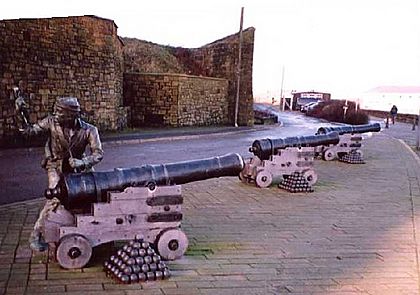
Here are some notable people connected to Whitehaven:
- Abraham Acton (1893–1915), a soldier who won the Victoria Cross in World War I.
- Kyle Amor (born 1987), an Ireland international rugby league player.
- William Brownrigg (1711–1800), a doctor and scientist.
- Scott Carson (born 1985), a footballer.
- Mildred Gale (1671–1701), the grandmother of George Washington, lived and is buried in Whitehaven.
- Dean Henderson (born 1997), a Premier League footballer.
- John Paul Jones (1747–1792), known as the "father of the American Navy", started his career in Whitehaven. He returned in 1778 to lead a naval raid on the town.
- Brad Kavanagh (born 1992), an actor.
- Gerard Richardson (born 1962), who started the International Maritime Festival.
- Frank Schon, Baron Schon (1912–1995), who helped start Marchon Chemicals.
- Miki Sekers (1910–1972), who helped start Sekers Fabrics.
- Jackie Sewell (1927–2016), a footballer.
- Jonathan Swift (1667–1745), the famous writer, claimed he was brought to Whitehaven as a baby.
- William Wordsworth (1770–1850), a famous poet, often visited Whitehaven.
Twin Cities
- Kozloduy, Bulgaria
Images for kids
See also
 In Spanish: Whitehaven para niños
In Spanish: Whitehaven para niños


